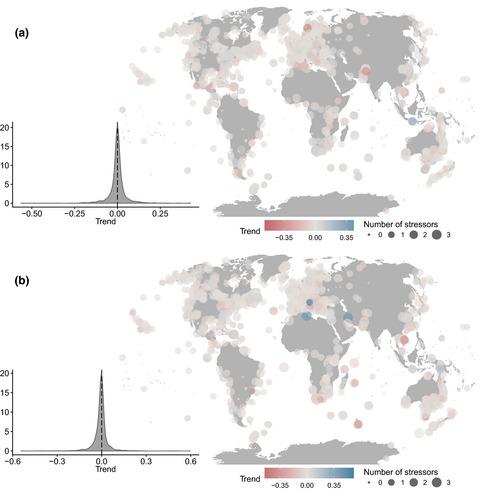当前位置:
X-MOL 学术
›
Ecol. Lett.
›
论文详情
Our official English website, www.x-mol.net, welcomes your
feedback! (Note: you will need to create a separate account there.)
Global patterns of resilience decline in vertebrate populations
Ecology Letters ( IF 7.6 ) Pub Date : 2021-11-16 , DOI: 10.1111/ele.13927 Pol Capdevila 1 , Nicola Noviello 1 , Louise McRae 2 , Robin Freeman 2 , Christopher F Clements 1
Ecology Letters ( IF 7.6 ) Pub Date : 2021-11-16 , DOI: 10.1111/ele.13927 Pol Capdevila 1 , Nicola Noviello 1 , Louise McRae 2 , Robin Freeman 2 , Christopher F Clements 1
Affiliation

|
Maintaining the resilience of natural populations, their ability to resist and recover from disturbance, is crucial to prevent biodiversity loss. However, the lack of appropriate data and quantitative tools has hampered our understanding of the factors determining resilience on a global scale. Here, we quantified the temporal trends of two key components of resilience—resistance and recovery—in >2000 population time-series of >1000 vertebrate species globally. We show that the number of threats to which a population is exposed is the main driver of resilience decline in vertebrate populations. Such declines are driven by a non-uniform loss of different components of resilience (i.e. resistance and recovery). Increased anthropogenic threats accelerating resilience loss through a decline in the recovery ability—but not resistance—of vertebrate populations. These findings suggest we may be underestimating the impacts of global change, highlighting the need to account for the multiple components of resilience in global biodiversity assessments.
中文翻译:

脊椎动物种群复原力下降的全球模式
保持自然种群的复原力、它们抵御干扰和从干扰中恢复的能力,对于防止生物多样性丧失至关重要。然而,缺乏适当的数据和定量工具阻碍了我们对全球范围内决定复原力的因素的理解。在这里,我们量化了全球 1000 多种脊椎动物的 2000 多个种群时间序列中弹性的两个关键组成部分——抵抗力和恢复的时间趋势。我们表明,种群面临的威胁数量是脊椎动物种群恢复力下降的主要驱动因素。这种下降是由弹性的不同组成部分(即阻力和恢复)的非均匀损失驱动的。增加的人为威胁通过脊椎动物种群的恢复能力下降而不是抵抗力来加速复原力丧失。这些发现表明我们可能低估了全球变化的影响,突出了在全球生物多样性评估中考虑复原力的多个组成部分的必要性。
更新日期:2021-12-10
中文翻译:

脊椎动物种群复原力下降的全球模式
保持自然种群的复原力、它们抵御干扰和从干扰中恢复的能力,对于防止生物多样性丧失至关重要。然而,缺乏适当的数据和定量工具阻碍了我们对全球范围内决定复原力的因素的理解。在这里,我们量化了全球 1000 多种脊椎动物的 2000 多个种群时间序列中弹性的两个关键组成部分——抵抗力和恢复的时间趋势。我们表明,种群面临的威胁数量是脊椎动物种群恢复力下降的主要驱动因素。这种下降是由弹性的不同组成部分(即阻力和恢复)的非均匀损失驱动的。增加的人为威胁通过脊椎动物种群的恢复能力下降而不是抵抗力来加速复原力丧失。这些发现表明我们可能低估了全球变化的影响,突出了在全球生物多样性评估中考虑复原力的多个组成部分的必要性。









































 京公网安备 11010802027423号
京公网安备 11010802027423号